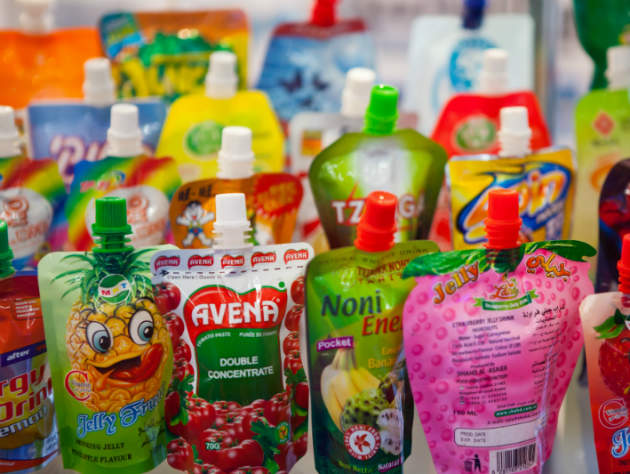

Flexible packaging has established a dominant position within the food and beverage sector. This is due to the fact that it is extremely versatile and can house a multitude of products. What used to be merely a low-cost option for manufacturers has turned into a credible delivery method which is now popular across a wide range of consumer goods, as well as increasingly replacing metal cans, glass and rigid plastic bottles, and cartons.

Discover B2B Marketing That Performs
Combine business intelligence and editorial excellence to reach engaged professionals across 36 leading media platforms.
According to Smithers Pira, the global market for flexible packaging is forecast to grow at an annual average rate of 3.4% during the 2015-2020 period, reaching $248 billion. Food packaging occupies over 70% of the global consumer flexible packaging market and is growing by 4.0% on average in volume terms, reaching over 18.8 million tonnes in 2015. We find out more about reclose systems and the flexible solutions on offer.
Different formats
One of the most recognisable and popular forms of flexible packaging is the pouch. Pouches are becoming one of the fastest growing packaging formats as they continue to replace rigid packs due to their strength, aesthetics, cost and environmental credentials.
Flexible packaging supplier Vowpack comments on their stand up pouches saying: “A plastic film pouch used to deliver concentrated fabric softener is 85% lower in weight and volume than a comparable plastic bottle, yet it delivers the same quantity of softener to the consumer. In addition, when dropped, a pouch will maintain its form and not break. Less energy used in manufacture means less cost for the client. Pouches are more flexible during the filling process too, as they can run on specific machinery or be hand filled. In fact, with minimal investment in a small sealing bar (less than £100), you can pack products at home.”
The pouch has become a firm favourite amongst both consumers and manufacturers and is being used for a vast selection of products. “Pouches continue to expand among developing countries as economy and/or refill packaging in laundry care, dishwashing and bath and shower. However, pouches will also grow their presence for tablet-format products to stand out on store shelves in Western Europe. In table sauces in Eastern Europe, pouches are perceived as value packs. They are also being used for their microwavability in canned food and also increasingly appeal as a convenient on-the-go solution such as in baby food” a Euromonitor report states.

US Tariffs are shifting - will you react or anticipate?
Don’t let policy changes catch you off guard. Stay proactive with real-time data and expert analysis.
By GlobalData“In North America and Western Europe, food manufacturers are offering consumers healthier snacking options. Pouches give the opportunity for such products to be more visible and brands to be better noticed on the shelves which is key against often high market saturation levels.”
Reclose systems
Reclose is the finishing touch that consumers come to expect on flexible packaging and a large percentage of flexible packaging does now incorporate reclose systems from reseal labels, to zips and press to close systems.
Packaging supplier Pulse Flexible Packaging offers various reclose systems such as Reseal-it – a reclose format that you simply peel to open and swipe to re-close – a Full Access Reseal-it Reclose strip – a unique, smart and reliable ‘no mess’, easy-open and re-sealing system that guarantees easy portion control – and lastly Velcro – an audible and tactile open function with a secure reclose.
In 2015 the supplier teamed up with Plasfilms for a Marks and Spencer food project. The project focused on a new pack development with an easy open and reclose system that allows for careful portion control and simple in-store display to attract the consumer. “The easy-open and re-close system was achieved with a simple tear notch, for convenient access to the product, while Plasfilms supplied a SANZIP MD10-TK re-close gripper ensuring an efficient re-close, time and again, allowing effortless portion control for the consumer. The MD10-TK offers a very strong inner holding force from the inside coupled with an easy-open feature for the consumer. The construction allows for an effortless crush on the side seal, which not only offers an attractive flat finish but a good barrier with little air escape. Converters benefit from being able to run the zipper at high speeds and at low sealing temperatures” the company said.
Speaking about the partnership, Anne Harding, print and packaging development manager at Marks & Spencer said: “Our collaboration with Pulse Flexible Packaging has seen great results; they have supported our vision with their own state-of-the art technologies as well as through their strategic partnerships. The pack fits the brief very well and looks great on-shelf.”
The future
The demand for flexible packaging looks only set to rise, particularly in the food and beverage industry. According to a Euromonitor report: “Flexible packaging enjoys the highest volume share in total food packaging, as bakery and confectionery products are becoming more widely accessible to rural consumers in the developing world. Traditional retailing and small, affordable pack sizes remain key to flexible pack growth in these markets.”
Looking ahead, aspects such as new packaging materials and digital printing will inject even more opportunity into the already innovative flexible market. Considering the entire pack as a whole – from materials to reclose systems – is crucial and all aspects should be given substantial thought. Reclose systems in particular have a duty to keep the product inside fresh and uncontaminated. Sourcing the ideal reclose system is not only a necessity for consumer health, but is also a very wise business decision and an imperative functionality aspect.





